|
The
Great Pyramid:
The
Pyramid of Khufu

Looking toward the south face.
After
the Great Pyramid was initially sealed, it's original entrance was hidden and
faced with smooth limestone. Because this blended in so well with the surrounding
casing, the opening was invisible. Around 820 AD, Abdullah Al Mamun mobilized
men to bore a tunnel into the pyramid to search for chambers and treasure. Due
to the difficulty of the task of breaking up the hard rock, fires were built
to heat the rock and then cold vinegar was poured over the heated rock. Battering
rams were used to pound away the weakened rock and clear a tunnel. Eventually,
a passageway was found which descended into the lowest chamber of the pyramid.
Following this passageway back upward, the original entrance was finally located.
In these pictures of the NORTH side you can see the intusive entrance lower
down, and the original entrance higher up flanked by angled stones.
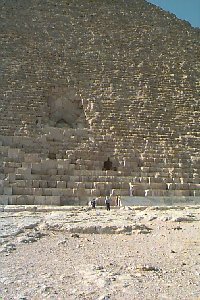
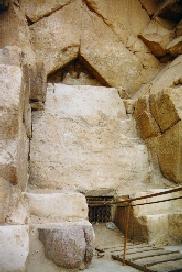
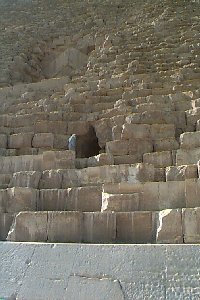
From
the outside, near the original entrance. In the left view on the lower left
you can see a granite block, believed to be one of the large portcullis blocks
that were originally lowered in the antechamber to seal the main burial chamber.
These have all been removed from there original place, this one remains here.
The picture on the right is looking down the original entrance through the
grating that is now in place, this passageway runs over 100 yards in length
to the subterranean chamber.
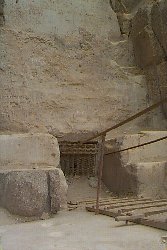
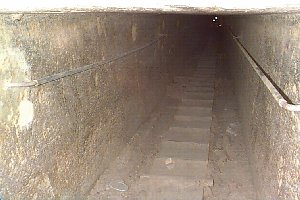
Here,
we enter the intrusive passageway, which in modern times is the main entrance.
You can notice the rough nature of this tunneling, while the original passageways
and chambers inside the pyramid are smooth and finished.

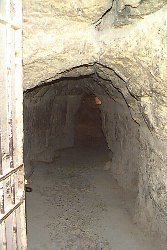
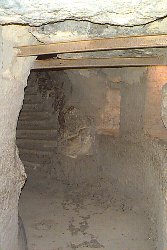
The
right view includes modern metal braces which were added to reinforce this
tunneled passageway.
As
mentioned, the original entry passageway was refound, this first view shows
the descending passageway leading into the lowest subterranean chamber, and
also leading back up to the original opening. During the intrusive tunneling,
supposedly the sound of falling rock was heard above revealing the existance
of an upper cavity. Al Mamun tunneled toward the sound and, amazing, burst into
an ascending passageway. The second view shows the original granite blocks,
known as portcullis blocks, that were set in place to originally seal access
to these upper passageways and chambers. When Mamun had bored through to the
ascending passageway he had tunneled just to the side of these blocks which
are still in their original place.
 

Now
steps lead you to a ramp that goes around the portcullis blocks and lead
up through the ascending passageway.
Follow
then as we enter the ascending passageway that leads to the magnificent Grand
Gallery. From here we can enter the two main chambers of the upper section,
now called the Queen's and King's chambers and explore the antechamber just
before the King's Chamber.
 To
go through the ascending passageway and explore the upper passageways
and chambers, To
go through the ascending passageway and explore the upper passageways
and chambers,
CLICK HERE!
Return
to Giza
Special thanks to:
Guardian's Egypt - Copyright © 1995-99 Andrew Bayuk All Rights Reserved
|





